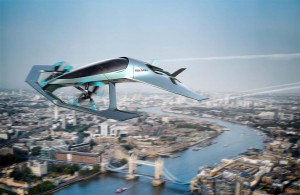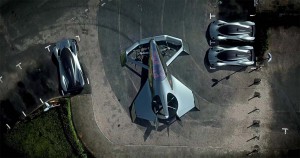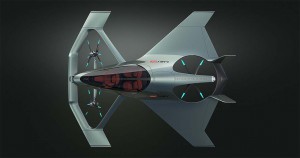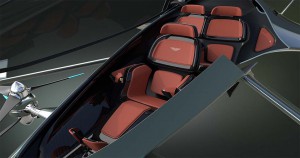We’ve heard some of Aston Martin’s products describes as “rockets” before. But now, it seems, the automaker truly does want to take to the air.
Aston today pulled the wraps off the Volante Vision Concept at the annual Farmborough International Air Show outside London. There are a number of projects currently underway to develop flying automobiles. Some are aimed at ride-sharing services like Uber, others for individual owners. The Volante Vision Concept, Aston explains, “aims to bring luxury personal transportation to the sky.”
The project teams the British automaker up with aerospace giant Rolls-Royce, Cranfield University and Cranfield Aerospace Solutions. The design they’ve come up with would have vertical take-off and landing, or VTOL, capabilities, potentially allowing it to take off from a parking lot or field, rather than having to go to a conventional airstrip.
“Air travel will be a crucial part in the future of transportation,” said Aston President and CEO Andy Palmer, adding the company’s goal is developing “the ultimate luxury mobility solution.”
(With AMR, Aston Rapide gets a little more rapid. Click Here for the story.)
With the Volante Vision Concept, Aston joins a growing list of players exploring the idea of flying cars and taxis. These range from a Slovakian start-up which showed off its AeroMobil Flying Car at the annual Top Marques Monaco in April 2017 to Airbus, Europe’s giant aircraft manufacturer.
Some, like Aeromobil and Terrafugia, an MIT spin-off, are targeting individual buyers looking for flying cars, while others envision something more akin to flying taxis. That’s the idea behind ride-sharing service Uber’s new Elevate project that could see service launch in Los Angeles and several other cities during the next five years.
“We are at the beginning of a new generation of urban transportation, vertical mobility is no longer a fantasy,” said Marek Reichman, Aston’s chief creative officer. “We have a unique chance to create a luxury concept aircraft that will represent the ultimate fusion of art and technology.”
Flying cars have been a fantasy for more than a century, industry pioneer Henry Ford working on a project widely known as the “Flying Flivver,” a reference using the nickname for the original Model T. A handful of flying cars actually took to the air in the post-War years, most notably the Aerocar first flown in 1949. But only six eventually were built.
(Click Here for details about Aston Martin recalling its entire run of DB11 coupes.)
During the last few years, there has been a burst of new interest, much of it driven by the increasing congestion that has brought traffic in many cities to a standstill. Some visionaries, Tesla’s Elon Musk, in particular, are looking at alternatives such as tubes and tunnels. But there’s now strong funding for taking to the air as a way to avoid traffic and expand the range people can routinely travel.
“Humans have always spent on average, one hour commuting to and from work,” said Aston CEO Palmer. “The distance we live from our workplace has been determined by the methods of transportation available. The Volante Vision Concept will enable us to travel further with our hourly commute, meaning we are able to live further away from where we work. Cities will grow, and towns that are today too far away from cities to be commutable will become suburban.”
As part of the Volante Vision study, Aston estimates a production version of the concept could make the run from London to Paris, a bit over 200 miles, in barely half an hour.
(To see more about Uber’s flight plans for Aeromobil, Click Here.)
For the moment, the flying Volante is more of a vision than an actual prototype, though Aston officials are expressing interest in possibly moving to the next level of development. The partners the company has chosen have the capability of getting there. Rolls, in particular, has worked on a number of critical aero programs that could provide technology for a VTOL, including the British Harrier jet.





Really interested and waiting to know more in practical , R&D, Need of time to reduce wastage of Energy in travel fatigue.
Would be happy to be part of team to execute the concept.
Milind
+91 9405258940